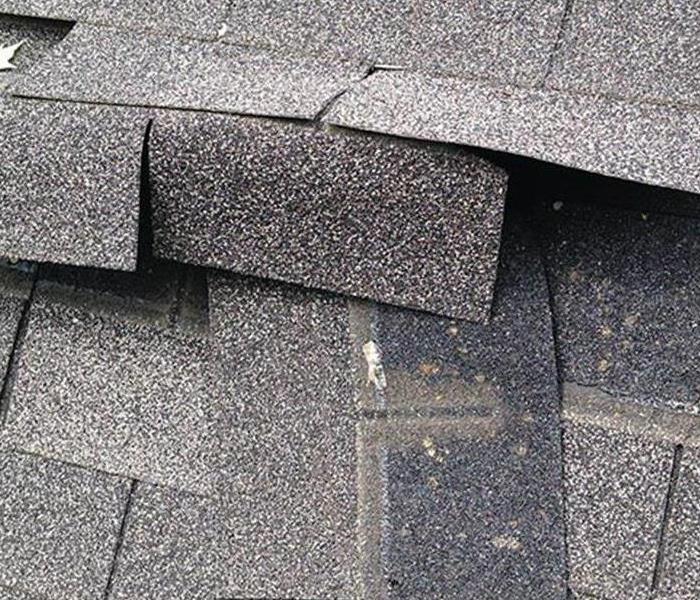Mother Nature Hits Again
5/5/2020 (Permalink)
When Mother Nature hits, it can hit hard, and your home is often in the path of destruction. Storm damage can cause expensive long-term problems when repairs aren’t carried out quickly. High winds, heavy rain, flooding, and even lightning can all cause damage to your home. From water running down roof beams into the walls to debris damaging windows, there are many ways a storm or tornado can damage your property. The sooner the damage is assessed, the quicker you can see the need for repairs – and start the insurance claim process.
Ten Steps to Check Your Home for Storm Damage
1. Check for Debris on the Roof
Tree branches and other debris can cause large problems to a home particularly the roof. A damaged roof can cause big problems, even if the impact site is only small. Water may leak in during the storm and may be unseen for some time until it pools and becomes a big problem. Clear any debris you can, if you can access it safely, and inspect the roof shingles for damage.
2. Look for Missing or Broken Roof Shingles
Scan the roof thoroughly. Are any shingles missing or slipped from the storm? A shingle that’s still on the roof but has slipped can still be a cause of water damage. Cracked shingles, if you can see them, are also a sign of weather damage to your home. This could indicate a larger impact from debris, too, which may have affected other parts of the roof.
3. Inspect Your Chimney Flashing and Gutters
The metal flashing around your chimney can come loose or been damaged during the storm. This could mean that there is the potential for water damage inside your home. Water runs underneath the flashing, down the chimney or roof beams, causing dampness. Gutters may also come loose or blocked during the storm. A blocked or loose gutter is a sign that your roof may not drain properly. Water pools on the roof can weaken the structure and cause water damage.
4. Assess Water Stains on Interior and Exterior Walls
Can you see any clear damp patches either outside or inside your home? Hard and heavy rains can cause water damage as water runs into small cracks in the walls. Exterior walls can take a few days to dry out, so by checking over a three day period will help you catch these cracks.
5. Check Exterior Walls for Holes
A classic sign of storm damage is a spider-web pattern of cracks that radiate out from a central point. This indicates an impact has occurred on the outside wall. Smaller signs of damage include chipped paint or plaster or minor holes in a stucco exterior.
6. Check Your Windows
Your windows may not be clearly broken by the storm, but give them a second look. Small cracks, glass panes that are loose, or even damaged window frames can all lead to much larger problems. Look for signs of water inside your windows, as this indicates a small leak that could be a big problem. Check also for damage caused by flying debris or high winds to your window frames. Dented or cracked frames can cause your window to become loose and a hazard.
7. Scan Your Soffits
When you get an opportunity where you can safely access your soffits, look closely at the surface. Any dents, cracks and paint chips caused by hail or debris may be a sign of a bigger problem underneath. If you see a dent or crack in your wooden or PVC soffits, inspect the area in more detail. Is the soffit loose? Has water been drawn into any areas it shouldn’t? Make a note of the dents and paint chips you can see: the more there are, the greater the chance of costly underlying damage.
8. Investigate Your Outbuildings and Fencing
When you’re checking your property after a storm, don’t forget any outbuildings or fences. Walk around your outbuildings and check for signs of water damage. Check windows and frames and make sure doors haven’t been damaged by high winds. Take a walk around your perimeter fencing. Make a note of any damaged or missing panels, or of damaged posts that will need to be replaced to secure your boundary once again.
9. Assess Trees and Pylons on Your Property
Check any pylons on or adjacent to your property for signs of damage caused by high winds. Slack or broken cables, or tilting pylons, are all cause for concern. Call the utility supplier as soon as you notice any problems, do NOT attempt to approach downed power lines. This can cause serious injury or even death. You should also check out the trees on your property for loose branches that pose immediate danger to vehicles or your home.
SERVPRO of Champaignn/Urbana is here to help! We can help with everything from tarping a roof to water clean up and much more. If you think your home has suffered at the hands of nature, give SERVPRO of Champaign/Urbana a call at 217-355-0077. Our friendly and caring staff are here to help get you and your family back to normal.





 24/7 Emergency Service
24/7 Emergency Service
